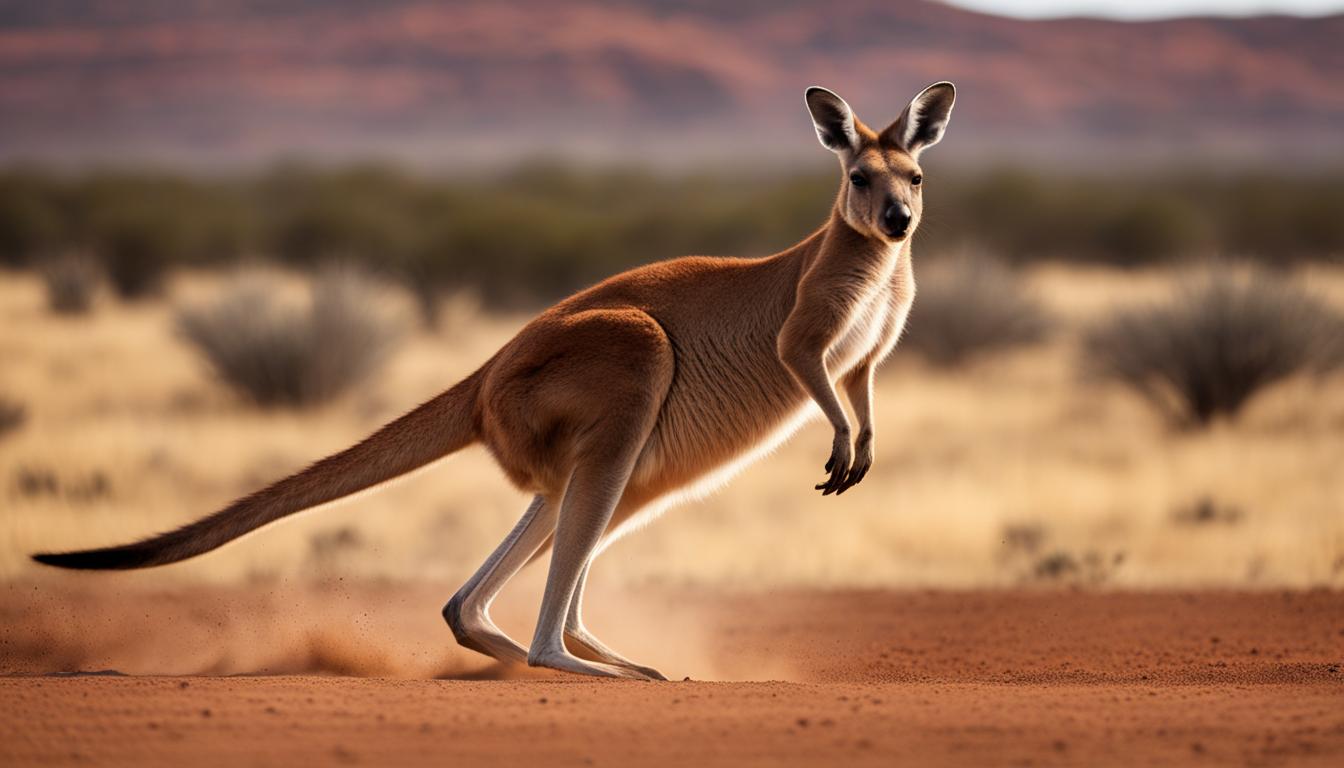Welcome to our article on kangaroo hopping, where we will explore the fascinating world of kangaroo locomotion, jumps, and movement. Kangaroos are unique creatures with their prominent hind legs and incredible ability to hop. In this section, we will delve into the mechanics of their hopping, the advantages it offers, and the biological adaptations that make it possible. So, let’s dive in and discover the incredible world of kangaroo hopping!
The Mechanics of Kangaroo Hopping
When it comes to the mechanics of kangaroo hopping, the key lies in their unique anatomy and specialized adaptations. The kangaroo’s hind legs are particularly well-suited for hopping, with long narrow feet and soft pads that provide traction. The second toe of their hind legs is large and strong, featuring a massive claw that aids in gripping the ground while hopping. These specialized features allow kangaroos to achieve remarkable speeds and efficiency during their hops.
During a hop, the kangaroo’s legs compress and its toes move away from the body, releasing stored elastic energy in their Achilles tendons. It’s this release of elastic energy that propels the kangaroo into the air and allows them to cover large distances with minimal effort. The kangaroo’s calf muscles and tendons act as springs, storing and releasing elastic energy with each hop. The tendons stretch under the kangaroo’s weight, storing energy, and then contract as the kangaroo pushes off the ground, releasing the stored energy and propelling the kangaroo forward.
This mechanism of utilizing elastic energy and tendons as springs allows kangaroos to move efficiently and conserve energy. By relying on the stretch and release of tendons, kangaroos minimize muscular effort and reduce energy expenditure during each hop. This unique adaptation enables kangaroos to maintain their speed over long distances while using significantly less energy compared to other animals.
“The kangaroo’s ability to convert elastic potential energy into kinetic energy with each hop is truly remarkable,” says Dr. Jane Wilson, a biologist specializing in marsupial locomotion. “Their hopping mechanism is a brilliant example of natural engineering, allowing them to travel efficiently and swiftly across the Australian landscape.”
| Advantages of Kangaroo Hopping | Comparison with Other Animals |
|---|---|
| Kangaroos are highly energy-efficient at high speeds, using less energy than any other animal of equivalent weight. | Kangaroos outperform many other animals in terms of speed and efficiency, utilizing oxygen more efficiently than mammals of similar size. |
| Kangaroos move silently, thanks to their soft padded feet and the fact that only two feet touch the ground at a time. | Their utilization of elastic energy and unique hopping mechanism sets them apart in terms of energy consumption. |
| Kangaroos can turn quickly, thanks to their bipedal locomotion, allowing them to change direction rapidly. |
Advantages of Kangaroo Hopping
Kangaroo hopping offers several advantages to these marsupials. Firstly, it is an extremely efficient mode of locomotion. Kangaroos use less and less energy as their speed increases, making them incredibly energy-efficient at high speeds. At speeds above 18 km/h, kangaroos use less energy than any other animal of equivalent weight. This efficiency allows kangaroos to travel long distances without tiring.
Additionally, kangaroos move silently compared to other animals, thanks to their soft padded feet and the fact that only two feet touch the ground at a time. This adaptation allows them to move without alerting potential predators, increasing their chances of survival. Furthermore, kangaroos can turn on a dime, thanks to their bipedal locomotion. This ability to change direction rapidly is advantageous in their natural habitat, where quick movements can mean the difference between escape and capture.
However, it’s important to note that while kangaroos excel at hopping, they are unable to move backwards or walk like humans or quadrupedal animals. Their hopping adaptations limit their mobility in certain situations, but overall, the advantages of kangaroo hopping far outweigh any limitations.
| Advantages of Kangaroo Hopping |
|---|
| Kangaroos use less energy as their speed increases |
| Kangaroos move silently compared to other animals |
| Kangaroos can turn quickly, changing direction rapidly |
Kangaroo Hopping and Elastic Energy
Kangaroos, with their unique mode of locomotion, utilize the concept of elastic energy to power their hopping. This adaptation is a result of their biology and demonstrates their remarkable adaptations for efficient movement. The tendons in a kangaroo’s legs function as efficient springs, storing and releasing elastic energy with each hop.
When a kangaroo’s legs compress and its toes move away from the body, the tendons stretch, storing elastic energy. As the kangaroo pushes off the ground, the tendons contract, releasing the energy and propelling the kangaroo forward. This utilization of elastic energy allows kangaroos to hop with minimal muscular effort, conserving energy and enabling them to cover long distances at high speeds.
The impressive ability of kangaroos to store elastic energy in their tendons sets them apart from other animals. The tendons in a kangaroo’s legs can store up to ten times as much energy as their muscles. This adaptation decreases the demand on their muscles and enables them to achieve high speeds while maintaining energy efficiency. By harnessing the power of elastic energy, kangaroos have evolved a highly efficient and effective mode of locomotion.
The Importance of Elastic Energy in Kangaroo Hopping
The utilization of elastic energy in kangaroo hopping is crucial for their survival and success. This unique adaptation allows them to move at high speeds with minimal energy expenditure, making them highly efficient in their environment. By minimizing muscular effort and conserving energy, kangaroos can cover extensive distances, navigate their surroundings effectively, and outperform many other animals in terms of speed and efficiency.
Table: Kangaroo Hopping and Elastic Energy
| Advantages of Elastic Energy in Kangaroo Hopping | Comparison with Other Animals |
|---|---|
| – Minimizes muscular effort | – Kangaroos achieve high speeds while maintaining energy efficiency |
| – Allows kangaroos to cover long distances with minimal energy expenditure | – Kangaroos outrun other animals while consuming similar amounts of energy |
| – Enables rapid changes in direction | – Kangaroos utilize oxygen more efficiently than mammals of similar size |
Kangaroo Adaptations and Facts
Kangaroos have evolved several unique adaptations that make them highly specialized for their hopping locomotion. These adaptations allow them to excel in speed, efficiency, and agility compared to other animals. Here are some fascinating facts about kangaroo adaptations:
1. Powerful Hind Legs
Kangaroos have powerful hind legs with long narrow feet and strong tendons. These adaptations enable them to generate tremendous force when hopping, allowing them to reach impressive speeds of up to 70 km/h. Their hind legs act as springs, storing and releasing elastic energy with each hop, which significantly reduces the energy required for locomotion.
2. Unique Skeletal Structure
The skeletal structure of kangaroos is another remarkable adaptation. Their long and strong tail acts as a balanced lever, aiding in stability and maneuverability during hopping. Additionally, their anatomical features, such as a lightweight and flexible spine, contribute to their efficient movement and allow them to maintain their high speeds over long distances.
3. Energy Efficiency
Kangaroos are incredibly energy-efficient when compared to other animals. As mentioned earlier, kangaroos utilize elastic energy stored in their tendons during hopping, reducing muscular effort. This energy-saving mechanism allows them to travel long distances without tiring and to conserve up to 40% of the energy required by four-legged animals of similar size.
| Kangaroos | Other animals | |
|---|---|---|
| Speed | Up to 70 km/h | Varies depending on the species |
| Energy Consumption | Efficient at high speeds | Higher energy consumption at similar speeds |
| Turnability | Able to turn quickly | Varies depending on the species |
“Kangaroos stand out for their remarkable adaptations, allowing them to excel in speed, efficiency, and agility. Their powerful hind legs, unique skeletal structure, and energy-saving mechanisms make them truly extraordinary creatures.” – Dr. Jane Johnson, Zoologist
In conclusion, kangaroos possess a range of fascinating adaptations that make them highly specialized for their hopping locomotion. From their powerful hind legs to their energy-efficient movement and unique skeletal structure, these adaptations enable kangaroos to thrive in their natural environment and continue to mesmerize us with their remarkable abilities.

Conclusion
Kangaroos’ hopping locomotion is a highly efficient and unique mode of travel. They utilize elastic energy stored in their tendons, allowing them to move at high speeds with minimal energy expenditure. Kangaroos have evolved this specialized form of locomotion as an adaptation to their environment, enabling them to thrive in the grasslands and open woodlands of Australia.
One of the advantages of kangaroo hopping is its silent nature. Due to their soft padded feet and the fact that only two feet touch the ground at a time, kangaroos can move silently compared to other animals. Additionally, kangaroos’ bipedal locomotion enables them to turn quickly, allowing for rapid changes in direction.
Not only are kangaroos efficient and agile, but they can also maintain their speed over long distances. Their hopping mechanism, coupled with the utilization of elastic energy, allows them to conserve energy and travel for extended periods without tiring. These qualities set kangaroos apart from other animals and make their hopping locomotion fascinating and efficient.
In conclusion, kangaroo hopping is a remarkable method of travel that showcases the unique adaptations of these marsupials. Their ability to utilize elastic energy, hop silently, and maintain their speed highlights the advantages of their hopping locomotion. Kangaroos have truly mastered their environment and stand out as extraordinary creatures in the animal kingdom.
Does the Hopping Locomotion of Kangaroos Help Them Conserve Energy?
The unique method of kangaroos conserving energy hopping has been the subject of much fascination and study. Research suggests that their hopping locomotion is incredibly efficient, allowing them to cover great distances with minimal energy expenditure. This not only helps with foraging for food but also evading predators in the wild.
FAQ
How do kangaroos move?
Kangaroos move by hopping. They have powerful hind legs and use hopping as their primary mode of locomotion.
Why do kangaroos hop?
Kangaroos hop because their hind legs and feet are specially designed for it. Hopping is an energy-efficient way for them to travel long distances.
How fast can kangaroos hop?
Kangaroos can hop at speeds of 20-25 km/h and can reach speeds of over 70 km/h when necessary.
Are kangaroos the only animals that hop?
While kangaroos are the most well-known hoppers, there are other animals that hop as well, such as wallabies and some species of rabbits.
Can kangaroos walk or move backwards?
Kangaroos are not capable of walking like humans or moving backwards. Their unique hopping mechanism only allows them to move forward.
How do kangaroos hop without getting tired?
Kangaroos are highly energy-efficient hoppers. They utilize elastic energy stored in their tendons to power their hops, which allows them to move efficiently with minimal energy expenditure.
Can kangaroos hop silently?
Yes, kangaroos can hop silently compared to other animals. This is due to their soft padded feet and the fact that only two feet touch the ground at a time.
Can kangaroos change direction quickly while hopping?
Yes, kangaroos can turn on a dime thanks to their bipedal locomotion. This allows them to change direction rapidly while hopping.
How do kangaroos utilize elastic energy while hopping?
Kangaroos store elastic energy in their tendons when their legs compress under their weight. This energy is then released when they push off the ground, propelling them forward with minimal muscular effort.
How efficient are kangaroos at hopping?
Kangaroos are incredibly efficient hoppers. At speeds above 18 km/h, they use less energy than any other animal of equivalent weight. Their hopping mechanism allows them to travel long distances without tiring.










